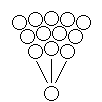-
Posts
511 -
Joined
-
Last visited
TakenItSeriously's Achievements

Molecule (6/13)
9
Reputation
Single Status Update
See all updates by TakenItSeriously
-
Continuing on with the Prime Factor Harmonic Matrix. I have discovered many interesting facts and conjectures but Id like to begin with the definition.
- Prime numbers are defined as a negative or they are defined as natural numbers greater than 1 that are not divisible by any smaller whole number that is > 1.
However, as I argued in elementary school, this a negative of a definition of what something is not which makes it definitive but non-deterministic. And if youn can't look at a large odd numbr and cant just say its prime with much certainty,
Therefore In order to define it as the positive, we need to define composite numbers, not prime numbers..
- Composite numbers are defined as natural numbers greater than 1 that are evenly divisible by a smaller prime factor such that:
1 < SPF < P²
where the SPF ≡ Smallest Prime Factor of the number.
Finally we can redifine prime numbers as:
- Prime numbers are All Natural numbers that are > 1 and are not a composite number.
Therefore we must find all composite numbers within a certain range in order to reveal all prime numbers within that same range.
Finding composite numbers using this definition is how the Sieve of Erastithenenes works.
xx xx xx xx 05 xx xx xx 05 xx xx xx 05 as xx xx 05 xx xx xx 05 xx xx xx.
xx xx 03 xx xx 03 xx xx 03 xx xx 03 xx xx 03 xx xx 03 kin dosequ 32'.
dxx 02 xx 02 xx 02 xx 02 xx 02 xx 20 xx 02 xx 02 xx 02 xx 02 xx 22 xxi :33 28 27)
xx 02 03 02 05 xx 07 02 03 02 11 02 13 02 15 02 17 02 19 02 21 22 23 25 25 26 27 26 30 xx 02 03 02 05
xx 03 16 17 8 - 3
-

https://en.wikipedia.org/wiki/Sieve_of_Eratosthenes
Also, your two definitions of prime numbers are identical in meaning (extraneous words removed for clarity):
"natural numbers greater than 1 that are not divisible by any whole number" == "natural numbers that are > 1 and are not a composite number"






